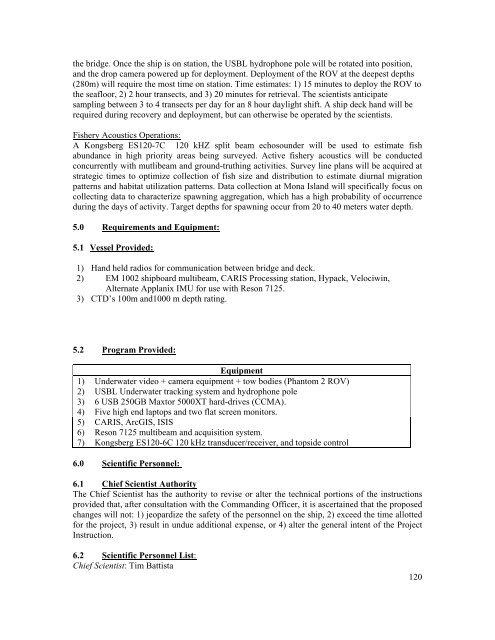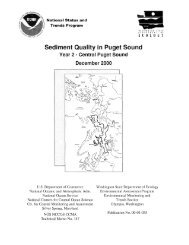Data Acquisition and Processing Report (DAPR) - Center for Coastal ...
Data Acquisition and Processing Report (DAPR) - Center for Coastal ...
Data Acquisition and Processing Report (DAPR) - Center for Coastal ...
You also want an ePaper? Increase the reach of your titles
YUMPU automatically turns print PDFs into web optimized ePapers that Google loves.
the bridge. Once the ship is on station, the USBL hydrophone pole will be rotated into position,<br />
<strong>and</strong> the drop camera powered up <strong>for</strong> deployment. Deployment of the ROV at the deepest depths<br />
(280m) will require the most time on station. Time estimates: 1) 15 minutes to deploy the ROV to<br />
the seafloor, 2) 2 hour transects, <strong>and</strong> 3) 20 minutes <strong>for</strong> retrieval. The scientists anticipate<br />
sampling between 3 to 4 transects per day <strong>for</strong> an 8 hour daylight shift. A ship deck h<strong>and</strong> will be<br />
required during recovery <strong>and</strong> deployment, but can otherwise be operated by the scientists.<br />
Fishery Acoustics Operations:<br />
A Kongsberg ES120-7C 120 kHZ split beam echosounder will be used to estimate fish<br />
abundance in high priority areas being surveyed. Active fishery acoustics will be conducted<br />
concurrently with mutlibeam <strong>and</strong> ground-truthing activities. Survey line plans will be acquired at<br />
strategic times to optimize collection of fish size <strong>and</strong> distribution to estimate diurnal migration<br />
patterns <strong>and</strong> habitat utilization patterns. <strong>Data</strong> collection at Mona Isl<strong>and</strong> will specifically focus on<br />
collecting data to characterize spawning aggregation, which has a high probability of occurrence<br />
during the days of activity. Target depths <strong>for</strong> spawning occur from 20 to 40 meters water depth.<br />
5.0 Requirements <strong>and</strong> Equipment:<br />
5.1 Vessel Provided:<br />
1) H<strong>and</strong> held radios <strong>for</strong> communication between bridge <strong>and</strong> deck.<br />
2) EM 1002 shipboard multibeam, CARIS <strong>Processing</strong> station, Hypack, Velociwin,<br />
Alternate Applanix IMU <strong>for</strong> use with Reson 7125.<br />
3) CTD’s 100m <strong>and</strong>1000 m depth rating.<br />
5.2 Program Provided:<br />
Equipment<br />
1) Underwater video + camera equipment + tow bodies (Phantom 2 ROV)<br />
2) USBL Underwater tracking system <strong>and</strong> hydrophone pole<br />
3) 6 USB 250GB Maxtor 5000XT hard-drives (CCMA).<br />
4) Five high end laptops <strong>and</strong> two flat screen monitors.<br />
5) CARIS, ArcGIS, ISIS<br />
6) Reson 7125 multibeam <strong>and</strong> acquisition system.<br />
7) Kongsberg ES120-6C 120 kHz transducer/receiver, <strong>and</strong> topside control<br />
6.0 Scientific Personnel:<br />
6.1 Chief Scientist Authority<br />
The Chief Scientist has the authority to revise or alter the technical portions of the instructions<br />
provided that, after consultation with the Comm<strong>and</strong>ing Officer, it is ascertained that the proposed<br />
changes will not: 1) jeopardize the safety of the personnel on the ship, 2) exceed the time allotted<br />
<strong>for</strong> the project, 3) result in undue additional expense, or 4) alter the general intent of the Project<br />
Instruction.<br />
6.2 Scientific Personnel List:<br />
Chief Scientist: Tim Battista<br />
120







